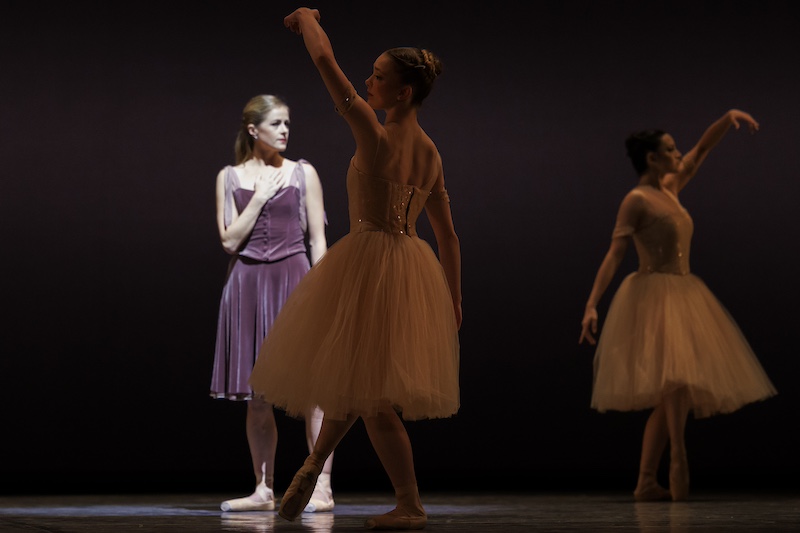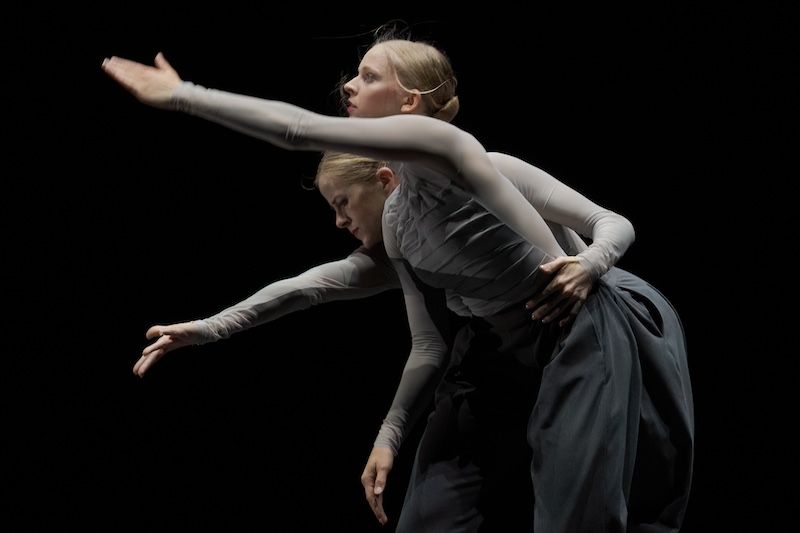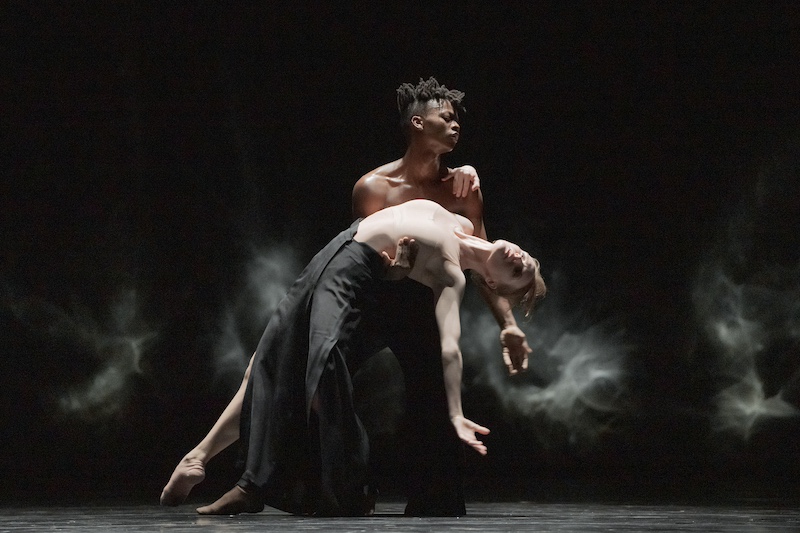What to expect of the National Ballet of Canada since its last London visit 11 years ago? Dance with an eco-message, a world-peace message, or more visible diversity on stage?
It's all there in the homegrown triple bill the company has brought to Sadler’s Wells. But the primary message seems to be that The Great White North has undergone a choreographic renaissance over the past decade, becoming a purveyor of hot-ticket choreographers to the wider world. This programme spans three generations of creators, each of whom challenges ballet tradition in their own way. In the case of James Kudelka, the senior name on the bill, the challenge of the piece he called Passion is simple verging on simplistic as he lobs a modern, dressed-down couple into the midst of a formally aligned, classical confection (pictured above) set to Beethoven. Part of the intrigue for me was the half-recognition of that famous music. It turned out to be Beethoven’s own piano arrangement (rarely played) of the first movement of his violin concerto – at once maddeningly familiar, yet also not – played from the pit with superbly stylish restraint by pianist Zhenya Vitort and what I can only guess was the uncredited Royal Ballet Sinfonia.
In the case of James Kudelka, the senior name on the bill, the challenge of the piece he called Passion is simple verging on simplistic as he lobs a modern, dressed-down couple into the midst of a formally aligned, classical confection (pictured above) set to Beethoven. Part of the intrigue for me was the half-recognition of that famous music. It turned out to be Beethoven’s own piano arrangement (rarely played) of the first movement of his violin concerto – at once maddeningly familiar, yet also not – played from the pit with superbly stylish restraint by pianist Zhenya Vitort and what I can only guess was the uncredited Royal Ballet Sinfonia.
As the strings’ stridently repeated D-sharps make their presence felt against the generally benign D major, five girls in Romantic tutus mark the pulse in decorous promenade, wrists neatly held in first position, heads tilted just so, smiles fixed. Meanwhile the modern couple stand at ease, eyeing each other up. He wears a T-shirt and slacks, she has long swishy hair. The couple’s lack of poise, of emotional restraint, is in marked contrast to that of their classical counterparts. Yet as the music winds on, it’s the latter whose story holds us. I found myself wanting the modern couple, with their disinhibition, their tedious full-on-ness, their sulks and sweaty hugs, to keep out of the way, still better, clear off. It occurred to me that the choreographer might even have had that in mind.
Yet I pity the choreographer who shares a bill with Crystal Pite. Massively ambitious in the scale and scope of her vision, she pulls it off every time – as witness the roster of world-class ballet companies currently jostling to have a piece of her. Sometimes her theme is more or less explicit, as in Flight Pattern, her piece about the refugee experience made for the Royal Ballet. Angels’ Atlas (pictured top and below), made for National Ballet of Canada in 2020, is more diffuse in the sense of what it might be “about”, but no less affecting for that. Pite has a rare talent for moving large numbers of people around a stage that makes them look at once more human and less. Massed together, they can be a surging ocean, the working parts of a factory, a herd of wildebeest. And when they detach from the crowd, individuals can seem both transcendent and alien.
Pite’s partner in work and in life, Jay Gower Taylor, provided the inspiration for Angels’ Atlas, with the result of experiments he’d been conducting into reflective light. His effects, created in real time on the back wall of the stage, are so awe-inspiring you feel an urge to "oooh" and "aaaah" as at the best kind of fireworks show. Yet these effects are monochrome: white cascades of what could be curling smoke or steam which slowly disperse like jet trails. And, like cirrus clouds, they are constantly changing. Their effect on the viewer is made more complex by a soundtrack that includes seraphic choral church music (including Tchaikovsky, sung in Russian) and terrifying rumbles that could be falling masonry. In a programme note Pite wrote of her intention to evoke in this piece "a fierce pulse of life". It's certainly fierce, but what makes Angels' Atlas almost overwhelming is its reminders of human folly and waste. Among the myriad synchronised gestures that give texture to the crowd scenes (and there must be 40-plus bodies on view, moving as one), are suggestions of the loading of automatic rifles, as well as profitable human toil. I wondered if the title gave a clue: just as Gaia theory posits that the Earth will outsurvive us, however we trash it, perhaps Pite's angels are the sad celestial watchers of our present predicament. Choreographers rarely strive to suggest great and ineffable things, and in my experience Pite is alone in her achievement. Never in my experience has such beauty, terror and pity been delivered on a theatre stage, and all in under half an hour.
In a programme note Pite wrote of her intention to evoke in this piece "a fierce pulse of life". It's certainly fierce, but what makes Angels' Atlas almost overwhelming is its reminders of human folly and waste. Among the myriad synchronised gestures that give texture to the crowd scenes (and there must be 40-plus bodies on view, moving as one), are suggestions of the loading of automatic rifles, as well as profitable human toil. I wondered if the title gave a clue: just as Gaia theory posits that the Earth will outsurvive us, however we trash it, perhaps Pite's angels are the sad celestial watchers of our present predicament. Choreographers rarely strive to suggest great and ineffable things, and in my experience Pite is alone in her achievement. Never in my experience has such beauty, terror and pity been delivered on a theatre stage, and all in under half an hour.














Add comment